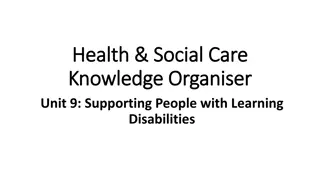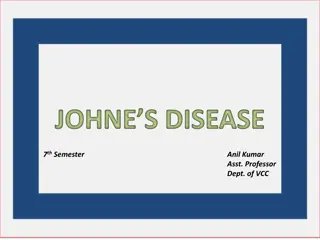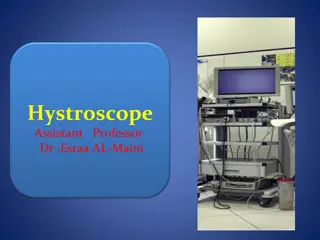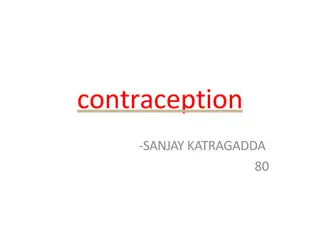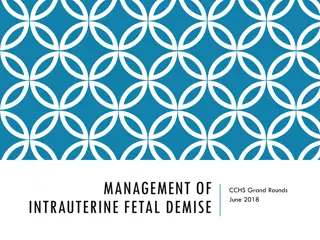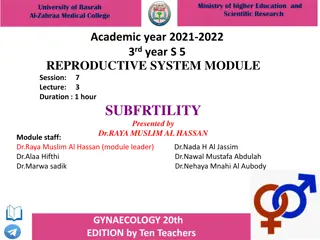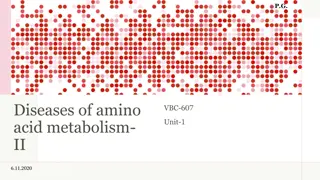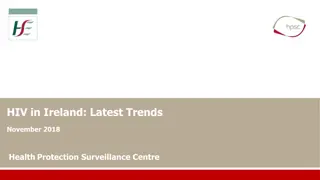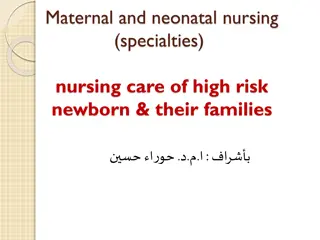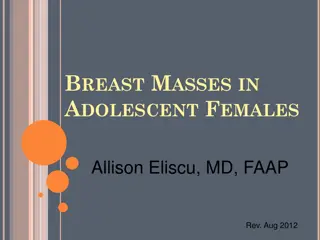Understanding Intrauterine Growth Retardation: Causes, Diagnosis, and Management
Intrauterine growth restriction (IUGR) refers to poor fetal growth in the womb, often due to maternal factors or inadequate oxygen supply. This condition can lead to increased risks for the baby. Topics covered include definition, incidence, normal fetal growth, stages, causes, diagnosis, and management of IUGR.
Download Presentation

Please find below an Image/Link to download the presentation.
The content on the website is provided AS IS for your information and personal use only. It may not be sold, licensed, or shared on other websites without obtaining consent from the author. Download presentation by click this link. If you encounter any issues during the download, it is possible that the publisher has removed the file from their server.
E N D
Presentation Transcript
SEMINAR ON : INTRA UTERINE GROWTH RETARDATION
OBJECTIVE Introduce the intrauterine retardation Define the intrauterine retardation Discuss the incidence of intrauterine retardation Discuss the normal fetal growth incidence of intrauterine retardation Discuss the etiology of intrauterine retardation Explain the classification of intrauterine retardation Explain the pathophysiology of intrauterine retardation Discuss the symptoms of intra uterine growth retatdation. Discuss the diagnosis of tntra uterine growth retardation. Describe the management
INTRODUCTION Intrauterine growth restriction (IUGR) refers to poor growth of a fetus while in the mother's womb during pregnancy. The causes can be many, but most often involve poor maternal nutrition or lack of adequate oxygen supply to the fetus.The growth of the fetus is abnormally slow. When born, the baby appears too small, relative to its dates. Intrauterine growth restriction is associated with increased risk of medical illness and death in the newborn.
DEFINITION Intra uterine growth restriction is said to be present in those babies whose birth weight is below the term the tenth persentile of the average for the gestational age. Growth restriction can occur in preterm,term or post-term babies.
Incidence In developed countries, its overall incidence is about 3-10% Term babies- 5% Post-term babies-15% 2nd leading contributor to the Perinatal mortality rate 20% of all stillbirths are IUGR. Incidence of intrapartum asphyxia in cases of IUGR has been reported to be 50%.
NORMAL FOETAL GROWTH Cellular hyperplasia. Hyperplasia and hypertrophy. Hypertrophy.
STAGES Stage- I (Hyperplasia) - 4 to 20 weeks - Rapid mitosis - Increase of DNA content Stages - Stage II (Hyperplasia & Hypertrophy) - 20 to 28 weeks - Declining mitosis. - Increase in cell size. Stages - Stage III ( Hypertrophy) - 28 to 40 weeks - Rapid increase in cell size. - Rapid accumulation of fat, muscle and connective tissue. 95% of fetal weight gain occurs during last 20 weeks of gestations.
CAUSES IUGR has many causes related to mother, foetus and placenta (part that joins the mother and foetus). Various risk factors for IUGR can be summarized as- :A. Maternal causes A. Maternal causes Before pregnancy Low pre-pregnancy weight and small maternal size Poor periconceptual nutrition. Multiple gestations
DURING PREGNANCY Poor weight gain during pregnancy, especially in latter half Moderate to heavy physical work cy Chronic illness such as malabsorption, diabetes, renal disease Use of certain drugs, smoking, and alcohol Pregnancy induced hypertension Decreased oxygen availability such as in high altitude, severe maternal anemia
B.UTERINE AND PLACENTAL FACTORS Inadequate placental growth Uterine malformations Decreased utero-placental blood flow (such as in toxemias of pregnancy, diabetic vasculopathy) Multiple gestations
C.FETAL CAUSES 1. Congenital Infections: The growth potential of fetus may be severely impaired by intrauterine infections. The timing of infection is crucial as the resultant effects depends on the phase of organogenesis. Viruses- rubella, CMV, varicella and HIV rubella is the most embryotoxic virus, it cause capillary endothelial damage during organogenesis and impairs fetal growth. Protozoa- like malaria, toxoplasma, trypanosoma have also been associated with growth restriction.
Conti.. 2. Structural Anomalies- All major structural defects involving CNS,CVS,GIT, Genitourinary and musculoskeletal system are associated with increased risk of fetal growth restriction. If growth restriction is associated with polyhydramnios, the incidence of structural anomaly is substantially increased. 3. Genetic Causes- Maternal genes have greater influence on fetal growth. Inborn errors of metabolism like agenesis of pancreas, congenital lipodystrophy, galactosemia, phenylketonuria also result in growth restriction of fetus
CLASSIFICATION Symmetric or primary IUGR: In this condition all internal organs are reduced in size. It is found in 20%- 30% of all cases of IUGR. Asymmetric or secondary IUGR: In this condition the head and brain are normal in size, but the abdomen is smaller. It is evident mostly in the 3rdtrimester. It is more common and found in 70% to 80% of total IUGR cases.
.Pathophysiology Pathophysiology Reduced availability of nutrients in mother. Reduced transfer by placenta to fetus. Reduced utilisation by fetus Brain size (asymmetric) as well as cell no (symmetric) are reduced Liver glycogen content is reduced Renal and pulmonary contribution to amniotic fluid are diminished due to reduced blood flow.
Conti.. Oligohydramnios Risk of intrauterine hypoxia and acidosis death if severe Accelerated maturation
conti... Accelerated fetal pulmonary maturation in complicated pregnancies associated with growth restriction Fetus responds to a stressed environment by increasing adrenal glucocorticoid production, which leads to earlier or accelerated fetal lung maturation
Symptoms The main symptom of IUGR is a small for gestational age baby. During the antenatal checkup, a doctor measures the height of the uterus from the pubic bone to estimate the size of the fetus. After about the 20th week, uterine fundal height in centimeters is usually equal to the number of weeks of the pregnancy. A lag in fundal height of 4 cm or more with weeks of pregnancy suggests IUGR, and additional tests are required to confirm diagnosis.
CONTI.. During ultrasound, the baby s estimated weight with IUGR is below the 10th percentile or less than that of 90% of babies of the same gestational age. At term, the birth weight less than 2,500 g (5 lb, 8 oz) is considered as IUGR. Not all babies that are born small have IUGR. In most severe cases IUGR can lead to stillbirth.
At term birth, symptoms of IUGR are: Baby is small all over or malnourished. Thin, pale, loose and dry skin Umbilical cord is thin and often stained with meconium
Diagnosis One of the most important things when diagnosing IUGR is to know accurate gestational age of baby. Gestational age can be calculated by using the first day of last menstrual period (LMP) and also by early ultrasound calculations. Once the gestational age is known the following methods can be used to diagnose IUGR.
FUNDAL HEIGHT It is the simplest and most common method to diagnose IUGR. Fundal height is size of uterus measured as the distance from the pubic bone to the top of the uterus in centimeters. After the 20th week of pregnancy, the measure in centimeters usually corresponds with the number of weeks of pregnancy. A lag in fundal height of 4 cm or more suggests IUGR.
WEIGHT CHECKUP Doctors routinely check and record the mother s weight at every prenatal checkup. If a mother is not gaining weight properly, it could indicate a growth problem in her baby.
ULTRASOUND It is used to measure the baby s head and abdomen and compared with growth charts to estimate the baby s weight. Ultrasound can also be used to determine amniotic fluid.
DOPPLER ASSESSMENT It is a technique that uses sound waves to measure the amount and speed of blood flow through the blood vessels. Doctors may use this test to check the flow of blood in the umbilical cord and vessels in the baby s brain. Abnormal Doppler tests are diagnostic of IUGR.
MANAGEMENT Constitutionally small. no intervention symmetric IUGR investigated for anomalies infections, genetic syndromes . Placental disease or reduced placental blood flow May be given some treatment. No effective therapy.
Conti. A..General No proven therapy for reversing IUGR once it has established 1. Adequate bed rest specially in left lateral position 2. Correct malnutrition by balanced diet- 300 extra calories per day 3. Appropriate therapy for complicating factors likely to produce IUGR 4. Avoidance of smoking, alcohol 5. Maternal yperoxygenation at the rate of 2.5 mL/min by nasal prong ,for short term prolongation of pregnancy 6. Low dose aspirin (50 mg daily) in selected cases with history of thrombotic disease, hypertension, pre- eclampsia or IUGR
CONTI.. Antepartum evaluation Serial evaluations of fetal growth and assessment of well being should be done- USG- intervals of 3-4 weeks for assessment of BPD, HC/AC, and fetal weight. Fetal well being- kick count, NST, biophysical profile, amniotic fluid volume and cordocentesis for blood gases Doppler ultrasound parameters
Conti.. Time of delivery Factors to be considered: 1. Presence of fetal abnormality 2. Duration of pregnancy 3. Degree of growth restriction 4. Associated complicating factor 5.Previous obstetric history 6. Availability of NICU
Conti.. Severe degree of IUGR- If lung maturation is achieved Presence of phosphatidyl glycerol and L:S ratio at least 2 from amniotic fluid study termination. Lung maturation not yet achieved problems- prematurity, growth restriction Preterm IUGR requires highest level of NICU Betamethasone therapy - <34 week Corticosteroid reduce risk of neonatal HMD and IVH
Conti.. Methods of delivery Route and time decided considering: 1. Severity of IUGR . 2. Maternal condition . 3. Any other obstetric complication Low rupture of membranes followed by oxytoxin. Beyond 34 weeks with favourable cervix and head is deep in pelvis. PGE2 gel when cervix unfavourable Intrapartum monitoring by clinical , continuous electronic and scalp blood sampling is needed as risk of intrapartum asphyxia is high
Conti.. Care during vaginal delivery- Equipped institution where intensive intranatal monitoring (clinical and electronic) is possible and having facilities for NICU. precautions Caesarean section without a trial of labour- when risks of vaginal delivery are more( fetal acidemia, absent or reversed diastolic flow in umbilical artery or unfavourable cervix)
Conti.. First stage- Ensure adequate fetal oxygenation by giving oxygen to mother by mask. Epidural analgesia is of choice. Labour carefully monitored preferably with continuous EFM Second stage. Birth should be gentle and slow to avoid rapid compression and decompression of head. Episiotomy may be done to minimise head compression Tendency to delay is curtailed by low forceps. Cord is to be clamped immediately at birth
Management protocol of IUGR- To confirm IUGR and type. To exclude cong malformation. To treat specific cause if found.
Conti.. Mild IUGR Increased rest. Folic acid Increased fliud intake Fetal monitoring till 37 weeks Delivery Dual problem
Conti.. care of low birth weight baby immediate management following birth - the cord is to be clamped quickly to prevent hypervolaemia and development of hyperbilirubinemia cord length is kept long ( 10-12 cm) in case exchange transfusion is required. Air passage should be cleared of mucus promptly and gently using a mucus sucker adequate oxygenation through mask or nasal catheter in concentration not exceeding 35% baby should be wrapped including head in a sterile warm towel (36.5-37.5 C) . aqueous solution of vitamin K 1 mg is to be injected i.M. To prevent haemorrhagic manifestations Hypothermia and sequelae: hypoxia hypoglycemia anaerobic metabolism metabolic acidosis
Conti.. Maintaining body temperature Delivery room dept warm, dry With mother- skin to skin contact Best placed in incubator where temperature and humidity(50%) can be better stabilised Under radiant warmer with protective plastic covers. Baby is placed naked. If not possible to maintain for entire room, cot is kept warm( 30 C). Rubber hot water ( not boiling) bottles stoppered and well covered with clothings
Conti.. Infection- Respiratory tract, GIT, skin, umbilicus Poor defensive power of neonates with low WBC count and poor phagocytic activity make baby more vulnerable Prophylactic antibiotic therapy in premature rupture of membranes Every precaution to prevent infection Ampicillin 100 mg/kg per day or amikacin 10- 15 mg/kg per day i.v. in 2 divided doses for 5-7 days Nutrition - Enteral feeding depending on gestation age and vigour May require gavage feeding/ parenteral nutrition Human milk is 1st choice.
Tube/ Gavage:- Fine polythene tube 0.5 mm internal diameter. Through nose down to oesophagus. Expressed milk is started with small volume and gradually build up. Continued for about 7 days. Calculated amount is injected with syringe by gravitation/pressure
Pipette, dropper, katori and spoon- where baby can swallow but fails to suck- Bottle- when baby can suck and swallow but can t manage to express milk from the breast. I.v. fluids- neonates within incubator/radiant warmer. Net reqt= 60-80 mL/kg/day of 10% dextrose water on 1st day, increase by 15 mL/kg/day. More amount(10%) if phototherapy
Additional supplements- Started after 2 weeks. Vitamin A 2500 IU, vitamin D 400 IU,vitamin C 50 mg, folic acid 65 g, vitamin B1 0.5 mg. Iron- liquid preparation 2-4 mg/kg/d in 2 divided doses calcium , phosphate. I.v. gamma globulin therapy(400 mg/kg/dose) to prevent infections <1200 g- parenteral nutrition with a.a, lipids with dextrose and multivita
Conti.. Favourable signs of progress- Colour of skin remains pink all the time Smooth and regular breathing Increasing vigour movements of limb, cry Progressive gain in weight.
Conti.. Discharge- When they attain sufficient weight About feeding schedule Prescribe suitable multivitamin and oral iron preparation To attend child welfare clinic for subsequent check up, immunisation and guidance Supervision continued at home by public health nurses or health visitors if possible.
COMPLICATION IUGR causes many health problems during pregnancy, delivery, and after birth. These include: Difficulty during vaginal delivery Low Apgar scores (a test done immediately after birth to evaluate the newborn s physical condition to determine need for special medical care) Meconium aspiration (inhalation of stools passed while in the uterus), which can lead to breathing problems low birth weight High red blood cell count Low resistance to infection
Prevention Care before pregnancy: Providing care to women before and between pregnancies (inter- conception care) improves the chances of mothers and babies being healthy. Advocating healthy eating and physical activity to women in their daily routine to improve weight and cardiovascular status before pregnancy. Diagnosis and management of chronic diseases such as hypertension, diabetes before pregnancy. Correction of anaemia/folic acid supplementation before pregnancy.
Conti.. Care during pregnancy: Pregnant mothers should take only those medicines which are prescribed by doctors. Healthy diet should be advised to pregnant women with behavior change to encourage healthier eating patterns during pregnancy. Foods fortified with nutrients can be provided to pregnant women. Pregnant women are advised to take enough rest with proper duration of sleep during night and an hour or two of rest in the afternoon. Expectant mothers should follow healthy lifestyle habits. Tobacco use, smoking and alcohol intake should be avoided during pregnancy.
Conti.. Care after delivery- Delivery should be planned in health facilities having emergency obstetric care and neonatal care facilities.
summary Intrauterine growth restriction(IUGR) is a medical term which refers to a baby who is not growing normally within the womb. In general, this label is for babies who weigh less than the 10th percentile for their gestational age, or period of pregnancy.
BIBLIOGRAPHY Ghai, O.P. (2008).Ghai essentials of paediatrics.(ed.6th).Delhi. O.P Ghai publishers. Gupta,P.(2004).Essentials of paediatric nursing.(ed.1st).New Delhi:A.P Jain &Co Publishers. Marlow.& Redding.(2008).Text book of paediatric nursing.(ed.6th).Philadelphia: Elsevier publications.P.NO.-57,58 Wong, D.L& Hockenberry.(2001).Wong s essentials of paediatric nursing.(ed.7th).Missouri: Mosby publications Parul Dutta, Paediatric nursing 2nd. edition P.No.23


